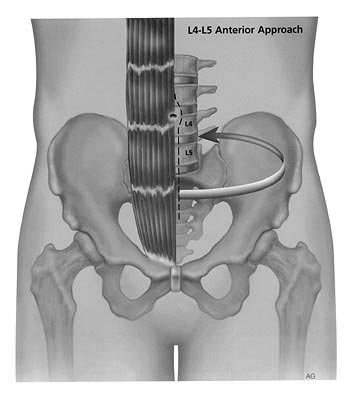Page 2 - Surgery #1 - Using Cadaver Bone To Enable Fusing
 Anterior lumbar interbody fusion (ALIF) was accomplished on the 3rd of November.
Anterior lumbar interbody fusion (ALIF) was accomplished on the 3rd of November.
The anterior lumbar interbody fusion (ALIF) is similar to the posterior lumbar interbody fusion (PLIF), except that in the ALIF the disc space is fused by approaching the spine through the abdomen instead of through the back.
In the ALIF approach, a three-inch to five-inch incision is made on the left side of the abdomen and the abdominal muscles are retracted to the side
Since the anterior abdominal muscle in the midline (rectus abdominis) runs vertically, it does not need to be cut and easily retracts to the side. The abdominal contents lay inside a large sack (peritoneum) that can also be retracted, thus allowing the surgeon access to the front of the spine.
In Sue's case, he scar was much larger... from the bottom of the picture shown below to the shoulder blade on the back! This was because T4 through S1 had to be accessed. Another smaller cut was made lower to get to the S1-L1 junction!
Minilaparotomy (One Small Incision) Was Not An Option
 The large blood vessels that continue to the legs (aorta and vena cava) lay on top of the spine, so many spine surgeons will perform this surgery in conjunction with a vascular surgeon who mobilizes the large blood vessels. After the blood vessels have been moved aside, the disc material is removed and bone graft, or bone graft and anterior interbody cages, is inserted.
The large blood vessels that continue to the legs (aorta and vena cava) lay on top of the spine, so many spine surgeons will perform this surgery in conjunction with a vascular surgeon who mobilizes the large blood vessels. After the blood vessels have been moved aside, the disc material is removed and bone graft, or bone graft and anterior interbody cages, is inserted.
The ALIF approach has the advantage that, unlike the PLIF and posterolateral gutter approaches, both the back muscles and nerves remain undisturbed. Another advantage is that placing the bone graft in the front of the spine places it in compression, and bone in compression tends to fuse better .
However, there is also a major risk that is unique to the ALIF approach. The procedure is performed in close proximity to the large blood vessels that go to the legs . Damage to these large blood vessels may result in excessive blood loss. Quoted rates in the medical literature put this risk at 1% to 15%.
